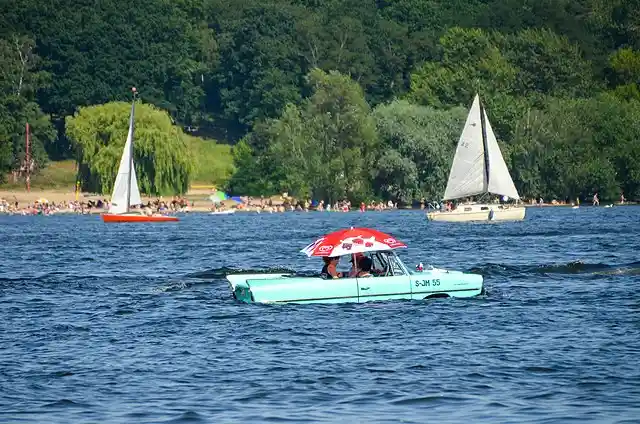Trippel
Looking back at historical pictures of past presidents, one would assume that President Lyndon Baines Johnson had a rather stoic personality. He was often captured with a stern facial expression or with a frown, while in the Oval Office.
However, LBJ was actually a bit of a prankster in his downtime, especially when he was home on his ranch in Stonewall, Texas. Evidently, one of his favorite pranks involved Trippel’s Amphicar Model 770, a car that swam.


Heinrich “Hanns” Trippel (1908–2001) was an innovative automobile designer of special buoyant and off-road vehicles. He was also a war criminal. After World War II, Trippel was sentenced to five years in a French prison. After serving three of those years, he was released on the condition that he cease developing or producing special vehicles. But he didn’t let a little thing like that stop him from pursuing his dreams.
Trippel came from humble beginnings and was expected to take over the family’s delicatessen business, but he wanted to go down a different path. Borrowing money from his father, he bought his first vehicle and rented an old horse bar to use as an auto shop. Trippel purchased an ancient Deutsche Kinder-Wagen and stripped it down and reformulated it to his own specifications. Trippel financed his automotive tinkering with winnings from driving in occasional car races.
The first modification was a streamlined aluminum body with a sharply pointed rear end. The second involved several attempts to make his car float. After several unsuccessful attempts, he finally triumphed in creating an amphibious vehicle.
This first model was financed by the Third Reich and manufactured for the Reichswehr (empire-defense), a German military organization. Trippel made several military vehicles during World War and was an active member of the SS, a combination that led to his conviction as a war criminal. Despite the terms of his release, Trippel found a way to continue making innovative vehicles, including the amphibious Amphicar Model 770.
Model 770
Amphibious vehicles are a hybrid of traditional motor vehicles and motorboats. They didn’t change structure like cartoons might suggest. The vehicles sported built-in watertight features and could simply be driven right into a body of water. They needed nothing more than the flip of a switch to change to propeller-driven transmission mode, which adjusted the steering wheel to control the rudders. Oars, life jackets, and boating lights were a standard feature.
The Model 770 referred to the top speeds the vehicle could manage: 7 knots on the water and 70 mph on land. The vehicle was manufactured in Germany, but Americans were the target market, with their 1960s love affair with sports cars and anything futuristic. Advertisements for the swimming sports car highlighted the convenience of cruising both open land and open waters.
There were great hopes for big sales, but even the beach-loving Americans could see beyond the kitschy novelty, wondering how often they’d really use the amphibious feature. Only 3,878 Model 770 vehicles were mass produced for civilian use. One American sold on the amphibious value was President Lyndon B. Johnson, or LBJ.
LBJ, Practical Joker
LBJ’s home was Stonewall, Texas, where he was born, lived when not at the White House, and eventually died and was buried. Although he and his wife, Lady Bird, had two daughters, they donated their private home to the National Park Service and gave lifetime usage rights.
LBJ was a bit of a prankster and loved practical jokes. Unsuspecting first-time visitors to the ranch, from friends to foreign dignitaries, were treated to a luxury tour in his unusual blue sports car. The catch was they were not told that the vehicle was amphibious.
As the travelers neared the big lake on the property and began their way up a very steep incline, LBJ would suddenly cry out that the brakes had failed. The frightened visitors reacted as you’d expect—praying, crying, screaming, and trying to get out of the vehicle. Just as the 770 hit the water, LBJ would double over laughing as they all safely floated out into the water.
Knowing this, no one would look at those presidential photographs with frowns and blank expressions in the same way. If you’re ever in Stonewall, Texas, be sure to take a tour of the ranch, where you can also see the original vehicle on display.